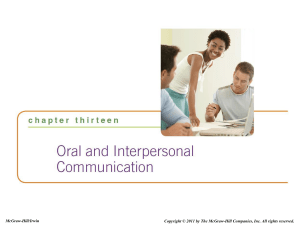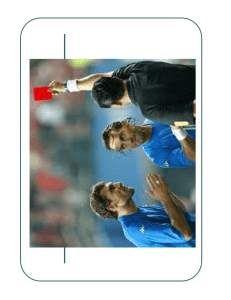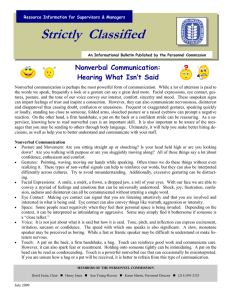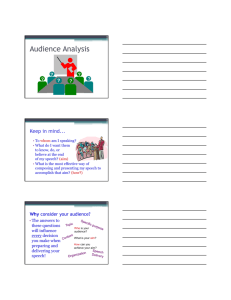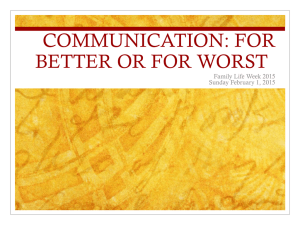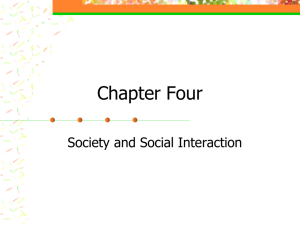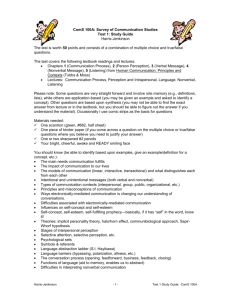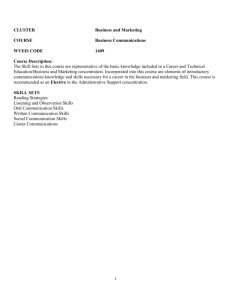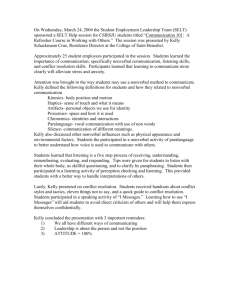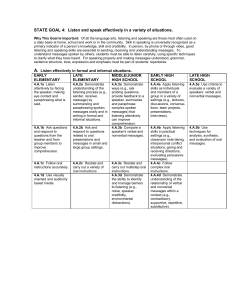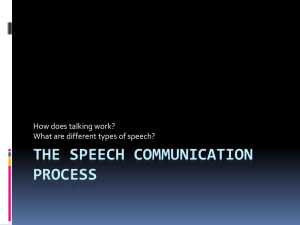Effective Communication in Healthcare: Student Handout
advertisement
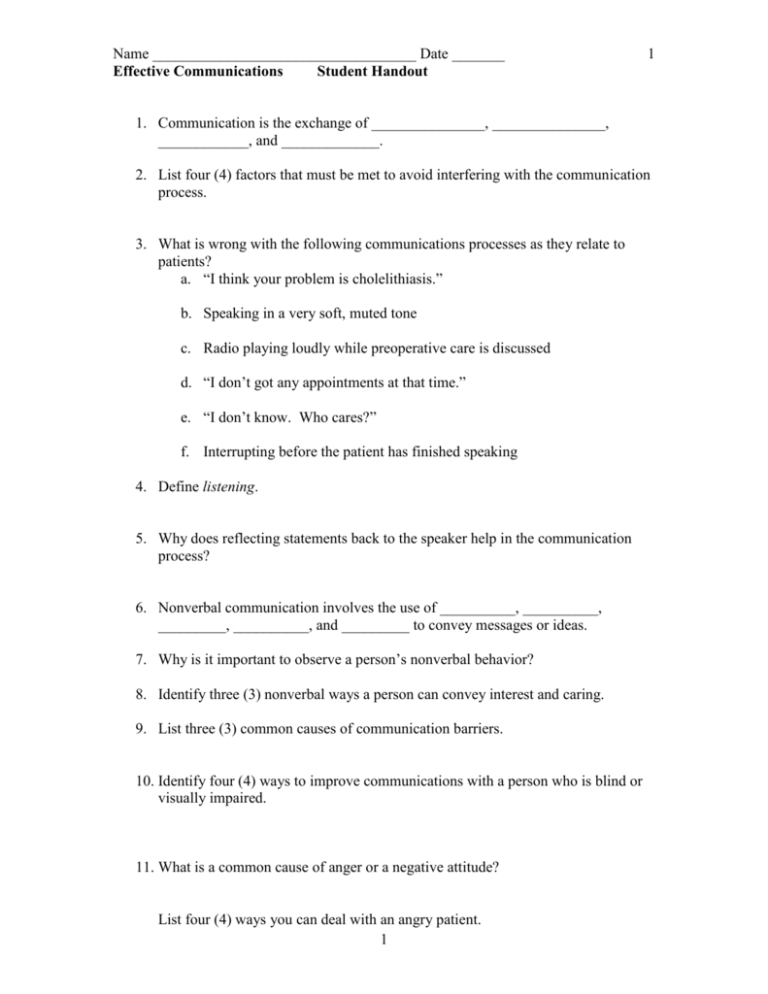
Name ___________________________________ Date _______ Effective Communications Student Handout 1 1. Communication is the exchange of _______________, _______________, ____________, and _____________. 2. List four (4) factors that must be met to avoid interfering with the communication process. 3. What is wrong with the following communications processes as they relate to patients? a. “I think your problem is cholelithiasis.” b. Speaking in a very soft, muted tone c. Radio playing loudly while preoperative care is discussed d. “I don’t got any appointments at that time.” e. “I don’t know. Who cares?” f. Interrupting before the patient has finished speaking 4. Define listening. 5. Why does reflecting statements back to the speaker help in the communication process? 6. Nonverbal communication involves the use of __________, __________, _________, __________, and _________ to convey messages or ideas. 7. Why is it important to observe a person’s nonverbal behavior? 8. Identify three (3) nonverbal ways a person can convey interest and caring. 9. List three (3) common causes of communication barriers. 10. Identify four (4) ways to improve communications with a person who is blind or visually impaired. 11. What is a common cause of anger or a negative attitude? List four (4) ways you can deal with an angry patient. 1 Name ___________________________________ Date _______ 12. What is culture? 13. How can you deal with or react to the following situations? a. You are preparing a patient for surgery and all jewelry must be removed. A patient refuses to remove a religious neck chain. b. A patient tells you, “I don’t believe in God.” c. A patient constantly avoids eye contact while you are talking to her. d. A patient with limited English nods his head but still seems confused as you explain a procedure. 14. Identify three (3) main barriers created by cultural diversity. 15. List four (4) senses a health care worker can use to make observations. 16. Differentiate between subjective and objective observations. 17. How should an error on a health care record be corrected? 18. Identify four (4) benefits patients experience when health care workers have effective communication skills. 2 2 Name ___________________________________ Date _______ Effective Communications Answer Key 3 1. Communication is the exchange of __information_, _thoughts_, _ideas__, and _feelings__. 2. List four (4) factors that must be met to avoid interfering with the communication process. 1. message must be clear 2. sender delivers message effectively 3. receiver must hear or receive message 4. receiver must understand message 5. avoid interruptions or distractions 3. What is wrong with the following communications processes as they relate to patients? a. “I think your problem is cholelithiasis.” Not in terms the patient can understand b. Speaking in a very soft, muted tone Receiver may not be able to hear message c. Radio playing loudly while preoperative care is discussed Distraction of the radio interferes with message d. “I don’t got any appointments at that time.” Using slang or incorrect grammar e. “I don’t know. Who cares?” lack of interest shown f. Interrupting before the patient has finished speaking Poor listening 4. Define listening. To pay attention to and to make an effort to hear what the other person is saying 5. Why does reflecting statements back to the speaker help in the communication process? Lets the speaker know statements are being heard and allows speaker to clarify a message 6. Nonverbal communication involves the use of __facial expressions__, _body language_, __gestures__, _eye contact__, and __touch___ to convey messages or ideas. 7. Why is it important to observe a person’s nonverbal behavior? often conveys a message that is different from the verbal communication 8. Identify three (3) nonverbal ways a person can convey interest and caring. 3 Name ___________________________________ Date _______ Touch of the hand, pat on back, firm handshake, hug 4 9. List three (3) common causes of communication barriers. Physical disabilities, psychological attitudes and prejudice, cultural diversity 10. Identify four (4) ways to improve communications with a person who is blind or visually impaired. 1. use soft tone of voice 2. describe events 3. announce your presence 4. explain sounds or noises 5. use touch when appropriate 11. What is a common cause of anger or a negative attitude? fear List four (4) ways you can deal with an angry patient. 1. allow patient to express fear 2. encourage talk about feelings 3. avoid arguing 4. remain calm 5. talk in a soft non-threatening tone of voice 6. provide quality care 12. What is culture? Values, beliefs, attitudes. and customs shared by a group of people and passed from one generation to the next 13. How can you deal with or react to the following situations? a. You are preparing a patient for surgery and all jewelry must be removed. A patient refuses to remove a religious neck chain. check with immediate supervisor patient may be allowed to leave the article in place b. A patient tells you, “I don’t believe in God.” Allow patient to express this belief and encourage the patient to talk, do not preach your own religion c. A patient constantly avoids eye contact while you are talking to her. Continue with communication, patient may not feel comfortable with eye contact, but may still be listening d. A patient with limited English nods his head but still seems confused as you explain a procedure. Ask questions to see if he understands or get a translator to explain 14. Identify three (3) main barriers created by cultural diversity. 1. beliefs and practices regarding health and illness 2. language differences 3. eye contact 4. ways of dealing with terminal illness and/or severe disability 5. touch 15. List four (4) senses a health care worker can use to make observations. 4 Name ___________________________________ Date _______ Sight, smell, touch, hearing 16. Differentiate between subjective and objective observations. Subjective observations cannot be seen or felt, objective observations can be seen or measured 17. How should an error on a health care record be corrected? Cross out neatly with a straight line, record “error” and initial 18. Identify four (4) benefits patients experience when health care workers have effective communication skills. 1. patients feel accepted 2. feel others have interest and concern in them 3. feel free to express their ideas and fears 4. develop confidence in health care worker 5. feel they are receiving quality health care 5 5
